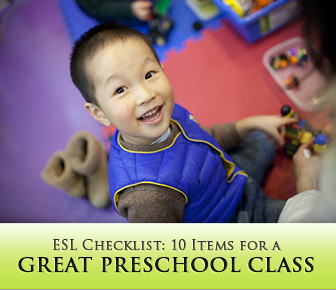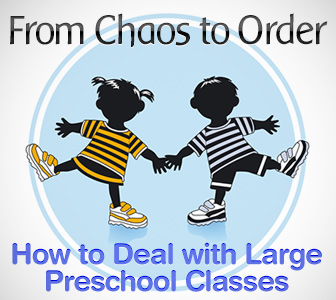ESL Checklist: 10 Items for a Great Preschool Class


Most don’t have goals for learning – they learn English because they’re told to. But they soon discover (and with our help) that learning English is fun, and they meet our suggestions for activities with great enthusiasm.
The problem arises when you have a large group of young learners. The usual complications of teaching a large class are compounded by the fact that preschoolers can’t read or write, least of all in English. Most activities will be games, TPR or crafts. They often get a little too enthusiastic…noise levels rise, smaller children get pushed, objects get thrown, and general mayhem ensues.
So, here are some tips for dealing with large preschool classes.

Unless you have a huge classroom, you won’t have enough room for TPR and activities that require racing, running, hopping or dancing.
Solution:
While we can’t control the size of our classroom, we can make the most of the space we do have. Instead of sacrificing these activities and keeping students at their desks, have them do versions of these activities while they stand on the same spot. Instead of racing to the board, they can raise their hand first. They can still spin around or touch their nose, head, etc…See if you have enough room to have them sit in a circle (or two concentric circles!) on the floor. They can still pass objects around, clap their hands, etc…but they won’t bump into each other or the furniture!
When you have a large class, there will inevitably be students who will be too far from the front of the classroom to see what you’re showing them. This leads to complaining (“I can’t seeeee!”), wailing or even students standing and walking up to get a better look.
Solution:
The best solution involves having large-sized flashcards, the bigger the better! It’s not hard to find big posters and illustrations that everyone can see. You may also want to consider blowing up copies of some illustrations or pages in your book. Finally, if all else fails, simply walk around the classroom and let everyone have a good look up close, particularly if you’re reading a story.
Of course, you’ll want everyone to participate, but the more children you have, the louder it gets. They may be singing quite nicely, but the teacher next door will find it disturbing to her class.
Solution:
Establish clear rules regarding when to speak (i.e, they must raise their hands first, not interrupt you or a classmate when they’re speaking, not shout, etc…) Regarding songs, chants or other loud activities, try to keep these to a minimum and make them last a few minutes. Introduce different “volume” levels, for example, start singing a song very softly and raise your volume as you repeat, till you finally sing it loudly.
This may be one of the biggest hurdles to overcome. The larger the class, the more copies, the more flashcards, the more glue, scissors, markers, etc… you need. Your school should be able to help you with some of these resources, but they will probably not buy more toy animals, plastic vegetables and fruits, or even more expensive supplies.
Solution:
Here’s where you’ll have to get creative – and crafty! Don’t have enough flashcards for a game? Have your students make some first! Do you run out of crayons faster than you can buy them? Gather broken crayons from other classrooms and teachers, and recycle them – make new ones! There are lots of activities you can do with your class by recycling materials they can bring from home – just ask each student to contribute, and soon enough, you’ll have more than enough!
And this is one of the biggest hurdles to overcome if you want your students to learn. The more students you have in your class, the fewer opportunities they will have to speak individually, and the fewer chances you’ll have of interacting with each one.
Solution:
This will take a lot of attention on your part, but you have to make sure you hear from each of your students at least once in each class. Try to spread out your interactions with the children so you’re not left only speaking to those who are the most enthusiastic. If you have a couple of eager beavers competing to answer all of your questions, praise them for their enthusiasm, but tell them that you’d also like to hear from someone who hasn’t spoken yet.
Split the class into two groups. Say you’re reading a story about Christmas. Tell Group A to draw something related to the holiday, for example how they celebrate it with their family. Read the story to Group B, followed by a Q&A session, while Group A completes their drawings. Then ask Group B to draw something related to the story, while you read to Group A. This strategy works great, provided you have enough space to set a group aside and not have them distract the other group. But the effort is well worth it, as you’ll have more students participate in answering questions.
You may not have enough space, time or materials, but make use of the resources you do have. And your little ones’ enthusiasm is one of the best resources there is!
If you have any tips to add, don’t keep them to yourself! Share them below!